More and more people are dissatisfied with their appearance and try to correct some parts of their body in some way. Madness sometimes happens, but increasingly everyone began to treat this with complete indifference as the demand for plastic surgery grows every year. For example, a nose job is one way to correct the shape of your nose, while a blepharoplasty corrects the eyelids and so on.

What is Rhinoplasty?
Rhinoplasty is an operation that changes the shape and, if desired, the size of the nose. The first such correction was made in the first half of the last century by a German surgeon named Jacques Josev. After this successful experience, this type of operation gained popularity every day and became even easier and safer thanks to the constant advancement of medicine and equipment. The essence of this surgical procedure is to change the bone and cartilage structure of the nose immediately after removing the skin. Despite the fact that this type of procedure is already very popular, there are still quite a large number of myths that can frighten the patient in one way or another.
Myths and Reality
The first myth is that this type of surgery can be performed by any plastic surgeon. In fact, a doctor in this specialization must have at least knowledge and at most superficial skills. Unfortunately, this does not mean that he has enough practical experience to carry out such an operation at the highest level. This procedure is very complicated, and every plastic surgeon should know all the nuances and subtleties of the structure of the nose and respiratory system, because the main task is not only the attractiveness of the patient, but also the correct functioning of the organ after the operation. In this case, the doctor must pay attention to the aesthetic proportions of the face.
It is believed that rhinoplasty is mainly done for people who have some kind of obsession with reshaping their bodies. But the fact is that the doctor himself can prescribe such a correction if the correct functioning of the respiratory organ is disturbed. At the same time, one should not deny that having a beautiful and graceful nose (especially in women) gives more confidence, which will definitely change life for the better. But to see this operation as a satisfaction of the inner "I" is completely wrong, rather as a modern form of psychotherapy.
Rumors that a nose job is a painful operation are not unfounded. Like any other surgical procedure, it comes with some risks, but when compared to the same breast augmentation procedure, the first one is less dangerous. As for the pain, the patient will not feel it as the entire procedure is performed under general anesthesia. After the operation, there is swelling and slight discomfort for 5-7 days, but no more.
Some people think that spring or summer rhinoplasty is better, but the reality is that it is a myth as the procedure can be done at any time of the year.
The best rhinoplasty is done by a professional doctor, after which there are no traces of the procedure. Whether the operation is noticeable or not initially depends on the degree of curvature.
Don't think that rhinoplasty can completely change the shape of the nose to make it perfect. Much is limited by the individual nature of the structure, skin and bone-cartilage framework, which is why patients can even be dissatisfied with the outcome of the operation. According to statistics, every tenth patient returns to the doctor after the tissue has healed to change the shape.
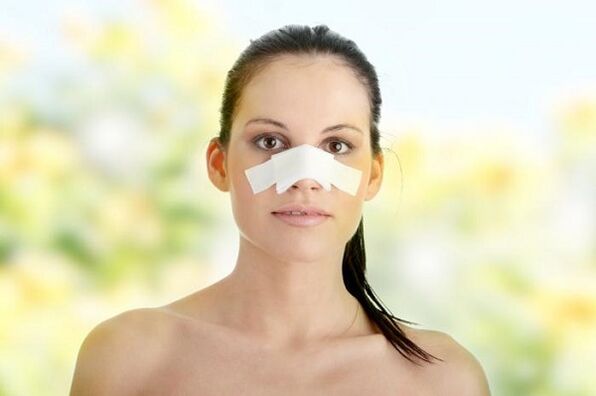
Choosing a new nose
In order to take into account the skills of the doctor and the needs of the patient, computer diagnostics are carried out, after which a photo will be provided to you. The rhinoplasty and, accordingly, the surgeon himself cannot go beyond the safe procedure if the shape of the nose does not allow the desired result. But the doctor will be able to offer the procedure that comes as close as possible to the ideal.
Based on the aesthetics of the parameters of the nose, more attention is paid to the profile angle, which is calculated by the line connecting the chin with the forehead relative to the bridge of the nose. For women, rhinoplasty of the tip of the nose is relevant if it is raised slightly above the level. Thanks to this correction, the face becomes noticeably younger. Do not forget that the shape is chosen by the surgeon with the greatest possible consideration of the parameters of the face. The operation must be carried out in such a way that the nose not only harmonizes with the rest of the body, but also gives the owner individuality.
Types of Rhinoplasty
Rhinoplasty is a surgical procedure that is represented by several types:
- open intervention;
- Surgery without skin removal (closed);
- Use of fillers;
- repeated (secondary);
- Columella surgery;
- Change in the shape of the nostrils;
- Rhinoplasty of a wide nose.
In the first method, the doctor makes an incision directly along the bridge between the nostrils to give the surgeon the best possible view. In this case, full control over the course of the operation is possible. In the closed method, the incision is made from the inside, which is less traumatic due to the use of fillers, as well as correcting the shape of the nose. Other types of procedures are determined based on the individual's anatomy.
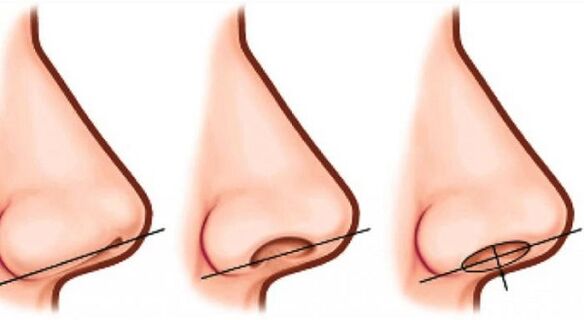
Rejuvenating rhinoplasty
Recently, the most popular type of rhinoplasty is a procedure that involves making a correction to reduce the age-related increase in the arch of the nose, sagging of the tip and base. Over time, what makes the woman look older becomes bigger and more distinctive. Plus, ears also increase with age so the surgeon needs to take this into account when making corrections so that everything is proportional. Even with a facelift, it is often necessary to correct the nose in relation to the new facial contour. The anti-aging rhinoplasty is, by the way, the most individual type. The prices for this type of correction also vary in individual cases.
Contraindications
There is a specific list of conditions under which the operation will not run:
- Rhinoplasty is not performed under the age of 18 unless it is a necessary post-injury measure.
- Inflammatory processes of the skin in the nose.
- Serious diseases of the internal organs that can cause complications.
- Infectious, oncological and acute viral diseases.
- Diabetes mellitus.
- Blood disorders.
Prepare for the operation
A high quality rhinoplasty is first and foremost a thorough understanding between the doctor and the patient. At the first appointment, the surgeon must respond to all requests. In addition, based on the requirements, the doctor should discuss possible techniques that will be relevant in the individual case. This is followed by an assessment of various nuances that can directly or indirectly affect the course of the operation. The choice of a particular technique is based solely on the following parameters:
- Customer requirements;
- the structure of the osteochondral corset of the nose;
- Condition and thickness of the skin;
- the age of the patient;
- Type of face.
At the same time, computer modeling is required, the purpose of which is to virtually create the shape of the nose using a special program. When choosing the surgical technique, the initiative is completely transferred to the surgeon. A thorough medical history is taken.
The doctor should inform his patient about the proper preparation for the operation. These include avoiding certain foods from the diet, the compulsory smoking cessation and restriction of the intake of certain liquids, especially alcohol.
The operation can be postponed if the patient has recently had a skin infection or upper respiratory tract disease. About 1-2 weeks before the correction procedure, drugs containing salicylates must be completely abandoned.
surgery
There are currently a sufficient number of private and public clinics that can perform a rhinoplasty. The prices in such medical institutions are based on the level of the institution, the equipment, the professionalism of the doctors and of course the procedure they offer and perform. Local anesthesia is often used and several sedative cubes are injected into the vein. There are times when general anesthesia is required. During the operation, the patient is under the constant supervision of special computerized devices that monitor the stable work of the heart, pulse and pressure.

At the end of all surgical procedures and interventions, the patient is transferred to the ward. Discomfort can often arise, but with appropriate targeted medication, these will quickly disappear. In some operations, it is necessary to put a special splint in place so that the nose is in a stationary state and is protected from accidental bruises. If a rhinoplasty has been performed, a special triangular bandage is put on for support, nasal splints can be used, which are placed inside. It is possible to leave the clinic within a few hours, but some patients choose to stay overnight.
execution
The operation itself does not take very long, about a couple of hours, it all depends on the method of intervention chosen and the initial complexity.
In the first phase, the atrium of the nasal mucosa is incised. After that, the surgeon needs to correct the tip of the nose, sometimes it is necessary to change the height of the nostrils and the width of the base of the nose. After removing the hump or the nose you get the necessary appearance, the final correction is made using cartilage, they can either be self or preserved. In the case of deformities, the operation is carried out parallel to the change in position of the nasal septum.
It is worth noting that after all the manipulations performed, the nose undergoes some changes that the surgeon cannot predict with 100% accuracy, this can be evidenced by numerous photos. Rhinoplasty is a very complex procedure, but there is a small percentage of unsuccessful procedures that can be attributed solely to the individual characteristics of the patient.
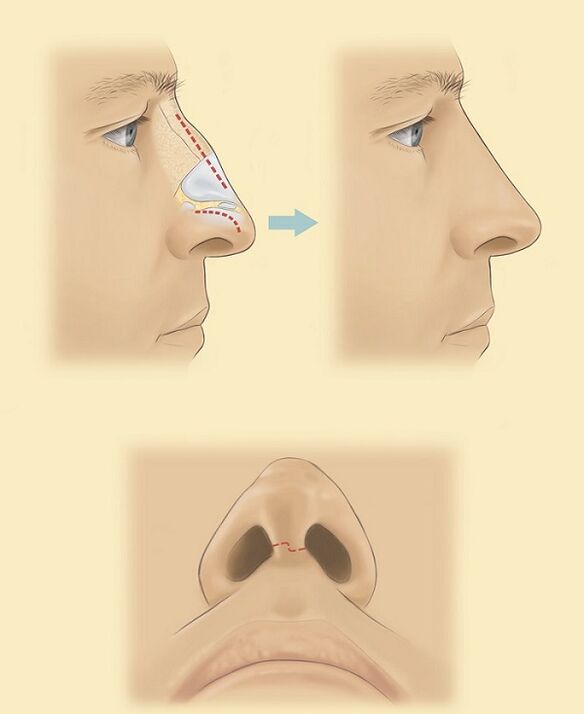
Possible complications
Any surgical procedure on the body is not natural and does not go away without a trace, and rhinoplasty is no exception. Surgeons, of course, must be highly qualified, but sometimes complications can arise that are solely related to individual characteristics. These include:
- anatomical structure;
- Response to anesthesia;
- Wound healing;
- Nosebleeds;
- the body's general response to surgery;
- Infection.
The risk of complications can be reduced to zero if you carefully follow all the doctor's recommendations.
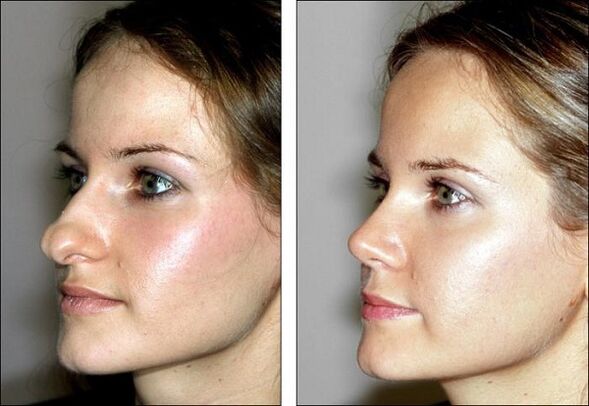
Restoration
In the first few days after the rhinoplasty, the nose can cause some discomfort. The appearance of puffiness around the eyes is also noted, but there is no trace of it after 4 days after the operation. After just 2 weeks, the nose will almost completely fix its final shape, but it will still be fully developed within six months. During this time, special care should be taken in caring for the skin around the nose, as it is particularly susceptible to damage. During this time, it is recommended to refuse to visit the sauna and to wear glasses for a month and a half.
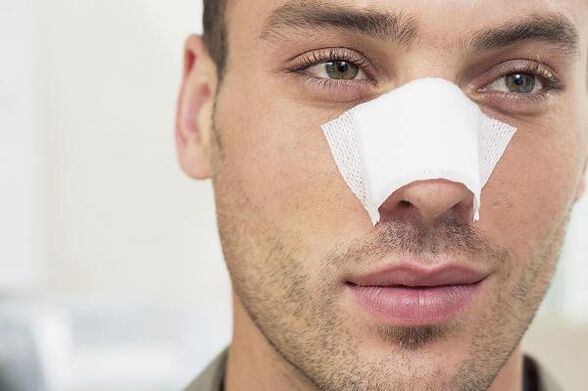
Return to normal life
If you do not exert yourself with great physical exertion, you can start your everyday life or even your work within 1 week of completing the operation. When resuming sport, it is recommended to start after 3-4 weeks at the earliest. You should also avoid direct sunlight on your face. In fact, any person can perform a rhinoplasty, but the desired result can only be achieved and consolidated only in full compliance with all the recommendations of the doctor.






















